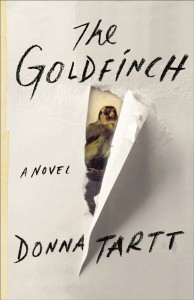A Goldfinch in Our Midst
Theo Decker is a thirteen-year old New York kid whose father left his mother and him a year earlier. It’s probably for the best, since his dad drank too much so he and his mom had to regularly navigate between his binges and his hangovers. They are in the New York Museum of Modern Art when an explosion rips the building and Theo’s life apart at the same time. His mother, just a hundred feet away, is killed immediately. Amidst the rubble, the dust, the fire and live electric wires, Theo crawls toward an opening, escape. He is given a ring by a dying man, along with instructions about where to deliver it. Theo also takes a small painting by an obscure Dutch painter, Fabritius. His intent is to save the painting from destruction. The painting is titled “The Goldfinch”, which is also the title of the new novel by Donna Tartt.
Theo escapes with his life and the painting which he has bundled up and is soon taken in by the wealthy family of his good friend Andy. The novel then follows Theo (and the stolen painting) through the next fifteen years of his life, working and living in an antique furniture store, falling in love, reuniting with his father and eventually accompanying his talisman painting into the criminal underworld and an ever-tightening, narrowing, dangerous circle. The authoress does a wonderful job describing Theo’s navigation through a landscape of post-trauma disorder, the jarring loss of his mother and the awkward manner that the people around him deal with his losses.
“The Goldfinch” has been described as being a modern Charles Dickens novel and I can see how and why this comparison has been made. Certainly, this tome is an epic novel, filled with descriptive detail and renders something of a coming-of-age story. But I think Tartt’s novel deserves to remain unique and not be overshadowed with allusions to authors dead now for more than two centuries. To be sure, Tartt presents a morality play in the novel. I also enjoyed her depictions and her blatant opinion of modern romantic love. My favorite section occurred toward the end of the novel, with the main character reflecting on Life and Death and his observations about Art dodging the Grim Reaper, himself.
Donna Tartt is an American author who published her first novel, “The Secret History” in 1992. Her second novel, “The Little Friend” appeared a decade later. “The Goldfinch”, Tartt’s third novel, was published last year, eleven years after its predecessor. It won the Pulitzer Prize for Fiction. It is obvious that Donna is meticulous about her work; her attention to detail is astounding, her analogies artistic. She has been described as dark and haunting but I think Donna falls into a category of writing that I like to refer to as “Twenty-First Century Writing”. I look forward to reading her next novel even if I have to wait another decade to do so. Hopefully, the wait will not be quite that long. In the meantime, I am going to search out her first two novels and read them, too!

